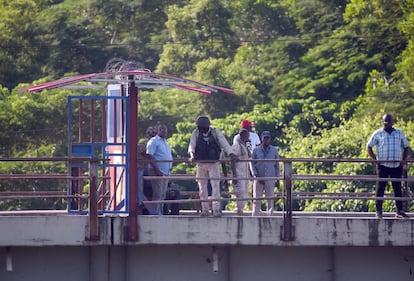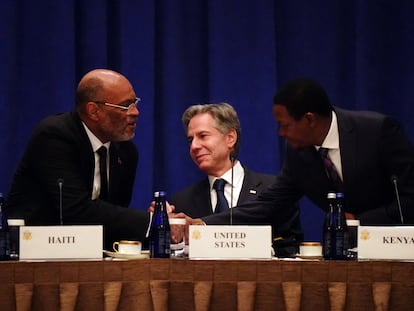Haiti’s crisis is worsening due to violence and an ongoing border conflict with the Dominican Republic
Criminal gang battles ravage the capital and central regions while a United Nations mission led by Kenya gears up

Haiti is in the throes of an existential crisis that is rapidly worsening due to violent criminal gangs that have seized control of large parts of the Caribbean country. Embattled leaders and ordinary citizens hope a United Nations peacekeeping mission and foreign aid will rescue Haiti from complete collapse. Meanwhile, life in the capital city of Port-au-Prince continues to deteriorate. The violence has also extended to the central and western regions of the country. In recent weeks, Route 3, a once safe road linking Port-au-Prince to border crossings and Cap-Haïtien in the north, is now controlled by criminal gangs and has become unsafe.
Haiti’s ongoing border conflict with the Dominican Republic has also escalated tensions. In September, Dominican President Luis Abinader closed his nation’s borders because Haitians built a canal to siphon water from the Massacre River that runs along the border. The shutdown paralyzed much of Haiti for nearly a month until the Dominican Republic agreed to allow limited commercial traffic. The border remains closed to all other traffic, causing frustration among Dominicans and Haitians in the western part of the island of Hispaniola.
Accustomed to a steady diet of bad news, Haitians finally received some encouragement from the international community. On October 3, the United Nations Security Council authorized a one-year deployment of a Kenya-led force to help stabilize the country. The objective is clear: to quell the criminal gangs that pose a threat to society, while concurrently working towards facilitating elections and restoring institutional stability.
Implementing the UN initiative is the next challenge. Kenya has committed to sending 1,000 police officers to supplement Haiti’s force of under 10,000 that seems powerless to ensure the safety of 12 million citizens. But sources in the UN say that least 2,000 foreign police officers are needed and the mission’s price tag remains a challenge. Despite the United States’ $200 million pledge, it’s clear that deploying and sustaining a large force will cost much more.
The UN resolution comes a full year after Haiti’s acting President Ariel Henry asked the international community for help. In September and October of last year, a cycle of violence and chaos ignited in the capital area, home to three million people. The government raised the price of gasoline, sparking violent protests. Criminal gangs soon took control of the fuel storage facility at the port. At the same time, Doctors Without Borders detected the first major cholera outbreak in years.
There has been no peace for Haiti since President Jovenel Moïse was assassinated in July 2021. Ariel Henry, who served as prime minister in the Moïse administration, has suffered relentless criticism after becoming acting president. Henry has not yet convened any elections, mostly due to his government’s inability to maintain law and order. Haiti has not held an election since 2016.

Violence and border disputes
Violence begets violence. After the chaos of last year, Port-au-Prince experienced a few months of relative calm, mostly because the criminal gangs controlled more than half the city, according to the United Nations. But violence erupted with a fury in April and May. Vigilante groups in neighborhoods like downtown Turgeau stood up to the gangs, and threw up makeshift barricades protected by anti-gang hexes. The vigilante groups called themselves bwa kale, crude slang in Haitian Creole for “erection.”
Unrestrained vigilante groups often react indiscriminately, and the bwa kale killed at least 300 people they suspected of being gang members. Haiti’s investigative agencies are so decimated they cannot effectively identify actual gang members, and will likely be unable to pursue and prosecute the perpetrators of these murders. As expected, the gangs struck back and the bwa kale have started to crumble. But there has been no letup in the rampant crime that plagues the country.
The gangs have recently attempted to position themselves as a viable political alternative to Henry. In September, Jimmy Cherizier, a former police officer and one of the leaders of the Port-au-Prince underworld, marched through the city with his militia announcing a gang coalition called Vivre Ensemble (Living Together) that aims to bring down Ariel Henry.
“A few days after that, the gangs were at each other’s throats again,” said Joseph Harold Pierre, a Haitian economist and political scientist. “They immediately started fighting, and a lot of folks in the Croix-des-Bouquets area had to leave their homes,” he said, referring to a large neighborhood that surrounds two of the main arteries into the capital. “You can’t really expect anything from them – they fight over everything.”
The renewed gang violence has several major impacts. Port-au-Prince lost one of the few somewhat safe routes to the north and the Dominican border. Route 3 is now controlled by gangs, much like Routes 1, 2 and 8 where through traffic is impossible. And now gangs have extended beyond the capital to municipalities like Mirebalais and further to the northwest.
The crisis is spreading to Artibonite, Haiti’s largest department. UNICEF released a statement on October 4 condemning the deteriorating situation in central Haiti. “The spread of violence from Port-au-Prince to Artibonite, Haiti’s main rice-growing region, is exacerbating an already critical humanitarian emergency... Nearly half of the 298 kidnappings countrywide during that period [May and June] took place in Bas Artibonite, or the lower part of Artibonite, mostly involving civilians traveling on public transport... In one incident, 15 women heading to market were reportedly kidnapped and raped.”
Sign up for our weekly newsletter to get more English-language news coverage from EL PAÍS USA Edition
Tu suscripción se está usando en otro dispositivo
¿Quieres añadir otro usuario a tu suscripción?
Si continúas leyendo en este dispositivo, no se podrá leer en el otro.
FlechaTu suscripción se está usando en otro dispositivo y solo puedes acceder a EL PAÍS desde un dispositivo a la vez.
Si quieres compartir tu cuenta, cambia tu suscripción a la modalidad Premium, así podrás añadir otro usuario. Cada uno accederá con su propia cuenta de email, lo que os permitirá personalizar vuestra experiencia en EL PAÍS.
¿Tienes una suscripción de empresa? Accede aquí para contratar más cuentas.
En el caso de no saber quién está usando tu cuenta, te recomendamos cambiar tu contraseña aquí.
Si decides continuar compartiendo tu cuenta, este mensaje se mostrará en tu dispositivo y en el de la otra persona que está usando tu cuenta de forma indefinida, afectando a tu experiencia de lectura. Puedes consultar aquí los términos y condiciones de la suscripción digital.
More information
Archived In
Últimas noticias
Welcome to the post-religion era: The idea of Christianity as the absolute truth has become obsolete
‘I thought you would like it’: The risky sexual practice popularized by TV shows and TikTok
The digitalization of tourism: ‘They promise experiences and gave us the worst possible one’
Mexican peso defies uncertainty with forecasts of a new period of stability in 2026
Most viewed
- Sinaloa Cartel war is taking its toll on Los Chapitos
- Reinhard Genzel, Nobel laureate in physics: ‘One-minute videos will never give you the truth’
- Oona Chaplin: ‘I told James Cameron that I was living in a treehouse and starting a permaculture project with a friend’
- Why the price of coffee has skyrocketed: from Brazilian plantations to specialty coffee houses
- Silver prices are going crazy: This is what’s fueling the rally











































